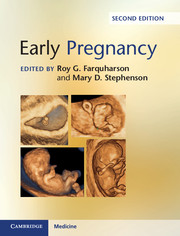23 results
Preface to the Second Edition
-
- Book:
- Early Pregnancy
- Published online:
- 16 February 2017
- Print publication:
- 02 February 2017, pp xi-xii
-
- Chapter
- Export citation
14 - The Value of Early Pregnancy Units
-
-
- Book:
- Early Pregnancy
- Published online:
- 16 February 2017
- Print publication:
- 02 February 2017, pp 146-150
-
- Chapter
- Export citation
Index
-
- Book:
- Early Pregnancy
- Published online:
- 16 February 2017
- Print publication:
- 02 February 2017, pp 325-335
-
- Chapter
- Export citation
Copyright page
-
- Book:
- Early Pregnancy
- Published online:
- 16 February 2017
- Print publication:
- 02 February 2017, pp iv-iv
-
- Chapter
- Export citation
15 - Investigation of Recurrent Miscarriage
-
-
- Book:
- Early Pregnancy
- Published online:
- 16 February 2017
- Print publication:
- 02 February 2017, pp 151-158
-
- Chapter
- Export citation
Plate Section (PDF Only)
-
- Book:
- Early Pregnancy
- Published online:
- 16 February 2017
- Print publication:
- 02 February 2017, pp -
-
- Chapter
- Export citation
Contributors
-
- Book:
- Early Pregnancy
- Published online:
- 16 February 2017
- Print publication:
- 02 February 2017, pp vii-x
-
- Chapter
- Export citation
Contents
-
- Book:
- Early Pregnancy
- Published online:
- 16 February 2017
- Print publication:
- 02 February 2017, pp v-vi
-
- Chapter
- Export citation

Early Pregnancy
-
- Published online:
- 16 February 2017
- Print publication:
- 02 February 2017
32 - Midtrimester Pregnancy Loss
-
-
- Book:
- Early Pregnancy
- Published online:
- 16 February 2017
- Print publication:
- 02 February 2017, pp 314-324
-
- Chapter
- Export citation
Preface
-
-
- Book:
- Early Pregnancy Issues for the MRCOG and Beyond
- Published online:
- 05 July 2014
- Print publication:
- 01 November 2011, pp xi-xii
-
- Chapter
- Export citation
Preface
-
-
- Book:
- Early Pregnancy
- Published online:
- 05 October 2010
- Print publication:
- 09 September 2010, pp xi-xii
-
- Chapter
- Export citation
Chapter 7 - Investigation of recurrent miscarriage
-
-
- Book:
- Early Pregnancy
- Published online:
- 05 October 2010
- Print publication:
- 09 September 2010, pp 59-66
-
- Chapter
- Export citation
Early Pregnancy - Title page
-
-
- Book:
- Early Pregnancy
- Published online:
- 05 October 2010
- Print publication:
- 09 September 2010, pp iii-iii
-
- Chapter
- Export citation
Contributors
-
-
- Book:
- Early Pregnancy
- Published online:
- 05 October 2010
- Print publication:
- 09 September 2010, pp vii-x
-
- Chapter
- Export citation
Contents
-
- Book:
- Early Pregnancy
- Published online:
- 05 October 2010
- Print publication:
- 09 September 2010, pp v-vi
-
- Chapter
- Export citation
Copyright page
-
- Book:
- Early Pregnancy
- Published online:
- 05 October 2010
- Print publication:
- 09 September 2010, pp iv-iv
-
- Chapter
- Export citation
Early Pregnancy - Half title page
-
- Book:
- Early Pregnancy
- Published online:
- 05 October 2010
- Print publication:
- 09 September 2010, pp i-ii
-
- Chapter
- Export citation
Chapter 1 - Early pregnancy – models of healthcare
-
-
- Book:
- Early Pregnancy
- Published online:
- 05 October 2010
- Print publication:
- 09 September 2010, pp 1-8
-
- Chapter
- Export citation
Chapter 26 - Late pregnancy loss
-
-
- Book:
- Early Pregnancy
- Published online:
- 05 October 2010
- Print publication:
- 09 September 2010, pp 277-286
-
- Chapter
- Export citation



